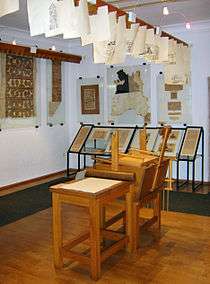Museum of Papermaking in Duszniki-Zdrój
|
| |
| Established | 1968 |
|---|---|
| Location | Duszniki-Zdrój, Poland |
| Coordinates | 50°24′16″N 16°23′45″E / 50.4044°N 16.3957°E |
| Type | history of paper |
| Director | Maciej Szymczyk |
| Website | http://www.muzpap.pl/ |
The Museum of Papermaking in Duszniki-Zdrój (pl.: Muzeum Papiernictwa) – a museum of the Lower Silesia Voivodeship Selfgovernment located in Duszniki-Zdrój in Poland, founded in 1968 in an old 17th century paper mill on the Bystrzyca Dusznicka river.
The museum displays mainly exhibitions on the history of paper. Since 2001 the museum has been organizer of "Święto Papieru" (The Holiday of Paper) – a festival promoting the knowledge and importance of paper, print, bookbinding and contemporary art.
The paper mill is one of Poland's official national Historic Monuments (Pomnik historii), as designated October 12, 2011 and tracked by the National Heritage Board of Poland.
Architecture
The paper mill is one of the most architecturally valuable industrial monuments in Europe. It is characteristic for its shingle roofing trimmed with a baroque volute from the west and the original entrance pavilion and inside the building – the 17-19th century wall paintings. The tradition of papermaking in Duszniki dates back to the 16th century; the first record about the paper mill comes from 1562, and tells about the sale of his shares in the moulding room by Ambrosius Tepper to Nicolas Kretschmer. The original paper mill was destroyed in the flood in 1601. The mill was rebuilt and making of paper was resumed in 1605. The museum was opened for visitors on July 26, 1968, and three years later paper production by hand was launched on show. The moulding room soon became an attraction drawing tens of thousands of tourists every year. The flood of 1998 inflicted a great damage on the paper mill. Water washed the foundations of the drying room and deposited tons of mud and debris inside the building. The damage was repaired thanks to the financial assistance from the Polish government. In 2007-2008 due to extensive alterations, the museum was adapted to the needs of disabled visitors.
Permanent exhibition

The museum is the only preserved and still running building of this kind in Poland and one of the very few in Central Europe. One can see here:
- the beautifully restored, shingle-roofed building of the paper mill – a unique monument of technology,
- production on show of handmade paper: "the hollander" for breaking cellulose, moulding vats, moulding frames and presses, etc.
- exhibitions on development of papermaking technology including sheets with watermarks and filigrees, historic moulding frames, models of papermaking machines and one of the greatest world-wide collections of historic apparatuses for measuring paper characteristics,
- exhibition on the history of painting,
- exhibition of original large-size papermaking machines,
- garden with fibrous plants used in paper production.
One can make their own piece of paper here:
- museum lessons are organized for groups,
- individual visitors can take part in papermaking workshops.
The museum outlet offers on sale:
- watercolour paper, drawing paper, printing and stationery paper up to A2 size,
- artistic paper ornamented with flowers and arms of County of Kladsko.
- business cards, stationery and other items up to A3 size, set by hand and printed on the premises.
- unique poetry albums in low stock,
- handmade paper with a specific watermark according to a client’s design or idea made to order.
The museum also makes a renowned centre of papermaking history research.
References
| Wikimedia Commons has media related to Museum of Papermaking in Duszniki-Zdrój. |
- F. Hohaus Die Papierfabrikation in der Grafschaft Glatz, "Vierteljahrschrift für Geschichte und Heimatkunde der Grafschaft Glatz", 1886
- F. Hössle Alte Papiermühlen der Provinz Schlesien, "Der Papier – Fabrikant", 1935
- W. Tomaszewska Historia zabytkowej papierni w Dusznikach, "Przegląd Papierniczy", XV/11, 1959
- W. Tomaszewska Z dziejów zabytkowej papierni w Dusznikach, "Przegląd Papierniczy", XXII/5, 1966
- W. Tomaszewska O papierze, który zyskał miano wiecznotrwałego, "Przegląd Papierniczy", XXIV/8, 1968
- Teresa Windyka Młyn papierniczy w Dusznikach, "Muzealnictwo", 41/1999



